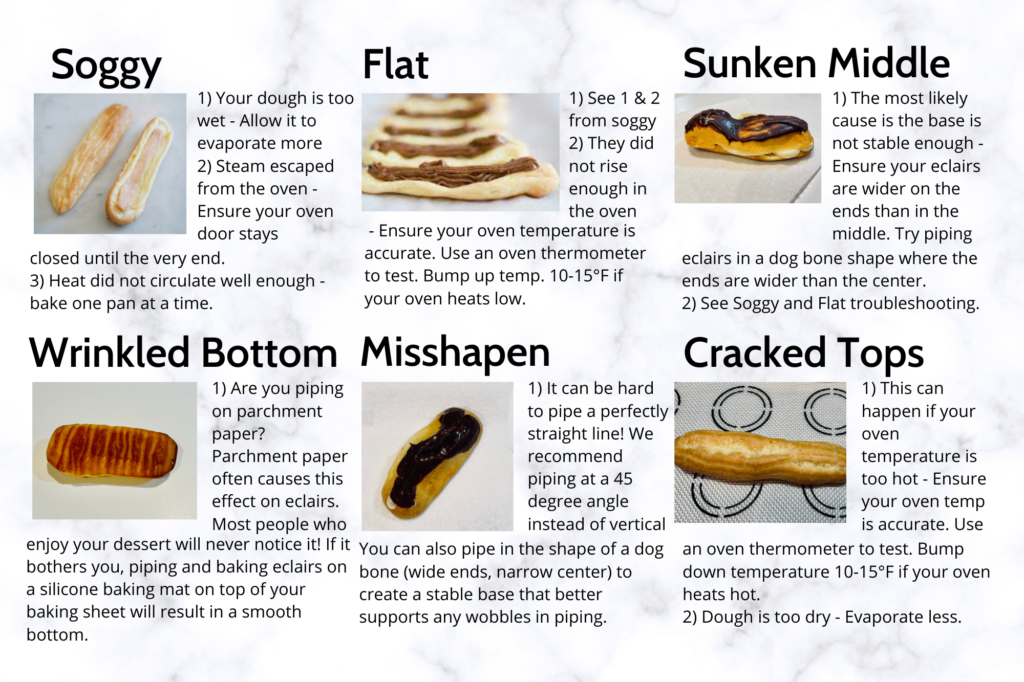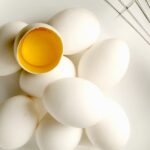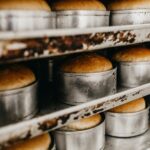A troubleshooting guide for eclairs, cream puffs, and profiteroles
Choux pastry also called pate a choux or choux paste, is a pastry recipe used to make eclairs, cream puffs, and profiteroles. The recipe is cooked twice – once on the stove, then in the oven. The result is a firm, yet hollow pastry that can be filled and topped in many ways for nearly any occasion.
Why is it called choux pastry?
Choux pastry (pronounced like “shoe pastry”) is French for cabbage. While the tasty treats made from choux pastry do not taste like cabbage, when you bake a cream puff or profiterole shell from choux pastry, it does look like a cabbage!
What are eclairs?
Eclairs are long, hollow pastries that are generally filled with pastry cream. Traditional eclairs are filled with vanilla pastry cream and topped with chocolate, but you can dress them up however you like! Check out our recipe for chocolate and raspberry eclairs!
What are cream puffs?
Cream puffs are round, hollow pastries that are often filled with flavored or natural whipped cream and topped with chocolate or another glaze.
What are profiteroles?
Profiteroles are very similar to cream puffs. They are round, hollow pastries that are filled with ice cream. Often, profiteroles are cut in half and the ice cream is added. Traditional profiteroles are filled with vanilla ice cream and topped with a chocolate drizzle, but you can change the filling and toppings to make all kinds of delicious treats!
Why is choux pastry hard to make?
It can be challenging to make your choux pastry hollow. You have to get three variables just right:
- Amount of moisture in your dough
- Amount of eggs in your dough
- How your dough is cooked – how long it is cooked and the temperature are both very important
Because choux pastry can be tricky to get just right, we created a guide you can use as a resource. The guide was created for eclairs, which are the most challenging of the three types of choux pastry desserts discussed in this article. Nearly every eclair baker runs into challenges at some point in their journey. Here are the most common issues and how to fix them. All troubleshooting sections apply to these three types of choux pastry except “sunken middle” and “misshapen” which only apply to ecliars.

Why are my eclairs soggy?
- Your dough is too wet – Allow it to evaporate more when cooking on the stove or when releasing the steam using your stand or hand mixer, before you add the eggs.
- Steam escaped from the oven – Ensure your oven door stays closed until the very end.
- Heat did not circulate well enough – bake one pan at a time.
Why do my eclairs have a wrinkled bottom?
Are you piping on parchment paper? Parchment paper often causes this effect on eclairs. Most people who enjoy your dessert will never notice it! If it bothers you, piping and baking eclairs on a silicone baking mat on top of your baking sheet will result in a smooth bottom.
Why are my eclairs flat? Why didn’t my eclairs rise?
- They did not rise enough in the oven – Ensure your oven temperature is accurate. Use an oven thermometer to test it. Bump up temp. 10-15°F if your oven heats low.
- Your dough is too wet – Allow it to evaporate more when cooking on the stove or when releasing the steam using your stand or hand mixer, before you add the eggs.
- Steam escaped from the oven – Ensure your oven door stays closed until the very end.
Why are my eclairs misshapen?
It can be hard to pipe a perfectly straight line! We recommend piping at a 45 degree angle instead of vertical. You can also pipe in the shape of a dog bone (wide ends, narrow center) to create a stable base that better supports any wobbles in piping.
Why do my eclairs have a sunken middle?
- The most likely cause is the base is not stable enough – Ensure your eclairs are wider on the ends than in the middle. Try piping eclairs in a dog bone shape where the ends are wider than the center.
- Are your eclairs also soggy or flat? See soggy and flat troubleshooting tips above.
Why are my eclairs cracked on top?
- This can happen if your oven temperature is too hot – Ensure your oven temperature is accurate. Use an oven thermometer to test it. Bump temperature down 10-15°F if your oven heats hot.
- Your dough is too dry – Evaporate less when cooking on the stove or when releasing the steam using your stand or hand mixer, before you add the eggs.


